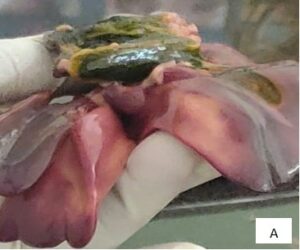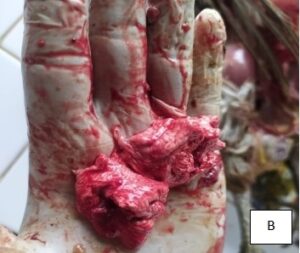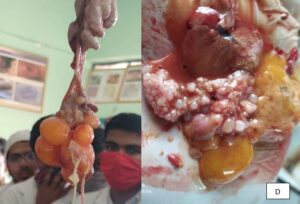BACILLARY WHITE DIARRHOEA (BWD) OR PULLORUM DISEASE IN A POULTRY FLOCK
D.T.NAIK 1, RAJENDRA KUMAR. T2., C.JYOTHI 3 and VIDYA SAGAR4
1) Professor and Head 2) Assistant professor 3) Assistant professor (contractual basis) 4) Assistant professor, Department of Livestock production and Management (LPM)
Department of Veterinary Pathology; Veterinary College, Bidar, Karnataka.
https://www.pashudhanpraharee.com/white-diarrhea-in-back-yard-poultry/
Ten Giriraja birds among which six adult birds aging 52-68wks and four young chicks aging 2-3wks, were presented to the Department of Veterinary Pathology, Veterinary college, Bidar, Karnataka for post-mortem examination from LPM department. Clinically, the birds were in sub-acute condition characterised by malaise, drowsiness, anorexia and reluctance to move. In one or two birds, diarrhoea was present with white diarrhoecals pasting the vents and feathers. The faeces were white in color and hence the name Bacillary White Diarrhoea to the disease. The infective organism (Salmonella pullorum) was present in the ovaries from which eggs had been laid got infected. The duration of the disease was 2 to 3 days and incubation period was 4 to 6 days. In young chicks, the clinical signs were inapperent. Adults were carriers leading to reduced fertility as well as reduced hatchability of the eggs. The organisms were voided through faeces. In this case also infection might have occurred by ingestion of contaminated food and water. The most important route of infection was by way of eggs. The eggs laid by the carriers were infected and the chicks that had hatched out were therefore infected. These chicks might have transmitted the disease to other healthy birds also. The shells of such infected eggs were source of infection. Feeding infected eggs to chicks was yet another method of infection.
The bacteraemia might have been subsided with organisms becoming localized in various organs in which necrotic foci were set up flaring up when animals were exposed to debilitating influences such as change in weather, prolonged transport, feeding excessive proteins and sudden change in the feed.
When the birds were opened for post-mortem examination, the vents were pasted with white diarrhoecals. Young chicks (2-3 weeks) did not show any lesions except congestion of the lungs (Fig. B). The lesions were hepatomegaly ( Fig. A) with catarrhal enteritis, hypertrophy of heart and pericarditis (Fig. C). The constant lesions were congested, haemorrhagic, ruptured, misshapen, cystic and stalked ovarian follicles (Fig. D). The entire reproductive tract showed congestion and mild hemorrhages.
Taking into consideration of all above criteria, the disease was diagnosed as Bacillary White Diarrhoea (BWD) or Pullorum disease morphologically.






